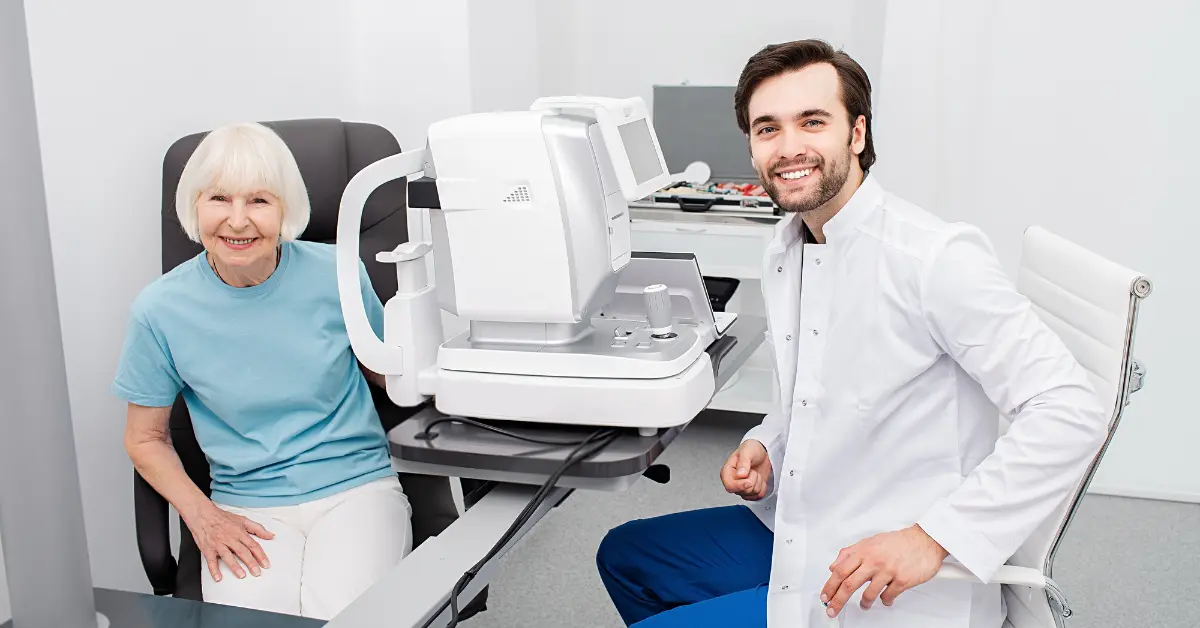Are Dry Eyes After Cataract Surgery Normal?
Cataract surgery is a normal surgical procedure but can cause side effects sometimes.
One such effect of this surgery is Dry Eyes.
A dry eye occurs when the eyes cannot generate enough tears or when the tears on the eye surface evaporate quickly.
As per a 2019 study, dry eye problems appeared in 42% of patients who underwent cataract surgery.
A 2017 research on 433 patients concluded dry eye was a side effect in 55.7 percent of cataract procedures.
Dry eyes following cataract surgery are common.
It can be painful and cause eye discomfort and hazy vision.
Continue reading to discover why dry eye develops after cataract surgery and how to treat it.
What causes dry eyes after cataract surgery?

After cataract surgery, dry eyes can appear for several reasons. The primary cause is the tear film on your eyes.
The tear film is a thin liquid film covering the eye’s surface.
It has three layers, namely, inner mucin, middle aqueous, and outer lipid layer.
The outermost lipid layer stabilizes the tear film by,
- Preventing tears from evaporating
- Keeping the eye surface smooth and moisturized
The lipid layer may become thinner after cataract surgery.
Dry eyes are the result of the tear film becoming fragile. It can also stem from,
- Corneal nerve damage – Tears are produced by the corneal nerves. Reduced blinking and tear production could result in dryness if the procedure harms a corneal nerve
- Exposure to light – Your surgeon will use a bright-lighting microscope during cataract surgery. Goblet cells lubricate the eye and may become less active in response to the light. Thereby causing dry eyes
- Inflammation – Nowadays, after cataract surgery, getting a rash is common. In this instance, eye irritation may cause you to produce fewer tears.
- Medicated eye drops – You’ll need prescription eye drops after surgery to control swelling and pain. These eye drops contain corticosteroids, preservatives, and painkillers, possibly inhibiting healing and worsening dry eye
How long does it last?

In general, eye dryness is worse during the first week after surgery.
A 2020 study found that the condition usually improves within a month after surgery.
Moreover, if you have experienced dry eyes before surgery, the operation can make them worse.
Following cataract surgery, additional risk factors that could raise your chance of developing the condition include,
- Being older
- Having underlying medical problems
- Using specific medications, such as nonsteroidal anti-inflammatory drugs (NSAIDs), post-surgery
Symptoms
Some common dry eye symptoms are,
- Blurry vision
- Burning sensation
- Eye pain and irritation
- Increased sensitivity to wind and light
Home remedies for dry eyes
If you have mild symptoms of dry eyes, some home remedies might help.
However, consult your doctor before adopting any home remedies.
- Artificial tears – Eye drops called artificial tears moisten your eyes. Eyemist E/D 10 ml is available at the pharmacy without a prescription
- Sunglasses – These will shield your eyes from the sun and wind, which can aggravate dry eyes
- Frequent blinking – Try to blink often, especially when reading or staring at computer screens. This may keep your eyes moisturized
- Stay hydrated. Drinking lots of water throughout the day is crucial because dehydration might worsen your symptoms
- Use a humidifier. Dry eyes may be a result of dry air. A humidifier adds the required moisture to the air and can aid in the reduction of dry interior conditions
- Nutritional supplements. Consult a doctor for dry eye supplements. Certain nutrients, including vitamin D and omega-3 fatty acids, may reduce eye inflammation
Treatment
You may require medical treatment if you develop severe symptoms of dry eye after cataract surgery.
Based on your symptoms and severity of eye dryness, an eye specialist may prescribe the following treatments,

Cyclosporine eye drops
Cyclosporine eye drops are medications commonly used to reduce inflammation in the eyes.
It is an immunosuppressive drug that works by suppressing the activity of T-cells.
These cells are a type of white blood cell that plays a role in the immune system’s response to inflammation.
By reducing the activity of these cells in the eyes, Cyclosporine eye drops can decrease inflammation and irritation.
Lifitegrast eye drops
Lifitegrast eye drops are used to treat dry eye disease.
These drops reduce inflammation on the eye surface.
Lifitegrast works by blocking the action of a lymphocyte function-associated antigen-1 (LFA-1) molecule. These are involved in the inflammatory response.
By blocking LFA-1, Lifitegrast reduces the activity of white blood cells that contribute to inflammation.
Punctal plugs
Punctal plugs are tiny, biocompatible devices inserted into the tear ducts to help retain tears on the eye surface.
Thereby reducing the dryness and irritation associated with dry eye disease.
By keeping the eye lubricated, punctal plugs can also help reduce inflammation.
Punctal plugs are often used in combination with other dry eye treatments, such as artificial tears or prescription medications.
This provides maximum relief for patients with chronic dry eye disease.
Overall, punctal plugs can effectively reduce inflammation and improve eye health in those with dry eye disease.
You will therefore need to keep using them if you start taking these medicines.
When should you see a doctor?
Following cataract surgery, you will generally visit an eye doctor for routine examinations.
These examinations give the doctor a chance to track your development. It also helps them keep an eye out for any potential issues.
Schedule an appointment with an eye doctor if you experience any of the following symptoms,
- Severe pain
- Vision changes
- Worsening eye dryness
- A severe itchy or gritty sensation
- Signs of an eye infection, such as red eye
- Swelling in the eye that does not go away or gets worse
The bottom line
Dry eyes after cataract surgery are a common complication.
It can occur due to damage to the tear glands or cornea, inflammation, or the use of certain medications during the surgery.
Symptoms of dry eyes may include itching, burning, redness, and sensitivity to light.
Treatment options available for dry eyes after cataract surgery include using artificial tears, prescription eye drops, warm compresses, inserting punctal plugs, etc.
In some cases, additional surgical procedures may be necessary to correct any underlying issues causing the dryness.
If you experience symptoms of dry eyes after cataract surgery, it’s essential to contact your eye doctor.
Early intervention can help prevent further damage and improve overall eye health and comfort.
Frequently Asked Questions
How long does dry eye last after cataract surgery?
Dry eyes after cataract surgery can last from a few weeks to several months. Treatment options such as artificial tears and warm compresses can help alleviate symptoms, but it’s essential to consult with your doctor for proper evaluation and management.
Can I use regular eye drops after cataract surgery?
It depends on the type of eye drops. Some eye drops may be safe after cataract surgery, while others may need to be avoided. It is important to consult with your doctor before using any eye drops after surgery.
Does cataract surgery make dry eyes worse?
Cataract surgery can sometimes worsen dry eyes. This may be due to various factors such as damage to the tear glands, use of medications during surgery, or corneal damage. However, proper management and treatment can help alleviate symptoms.
WowRx uses only high-quality sources while writing our articles. Please read our content information policy to know more about how we keep our content reliable and trustworthy.






